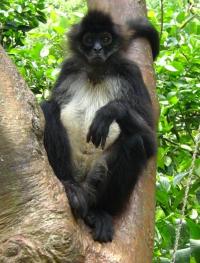Olfactory sensitivity of spider monkeys (Ateles geoffroyi) for structurally related pyrazines

Background:
Olfaction is traditionally thought to be of minor behavioural relevance in primates. Recent studies, however, suggest that primates have a well developed sense of smell. Among other things, it may play an important role in food selection.
Aims:
- Determine detection thresholds for food-associated odourants in spider monkeys
- Assess the impact of molecular structure on olfactory sensitivity
Method:
Detection thresholds were determined in four female spider monkeys for six structurally related pyrazines. The equipment used was a food-rewarded two-choice conditioning paradigm.

Results:
- All animals were highly sensitive to the substances tested
- More complex molecular structure generally resulted in lower threshold values
Conclusions:
- Spider monkeys have a well developed sense of smell and are sensitive to odourants associated with food
- Olfactory sensitivity is affected by molecular structure
Responsible for this page:
Director of undergraduate studies Biology
Last updated:
05/25/08
